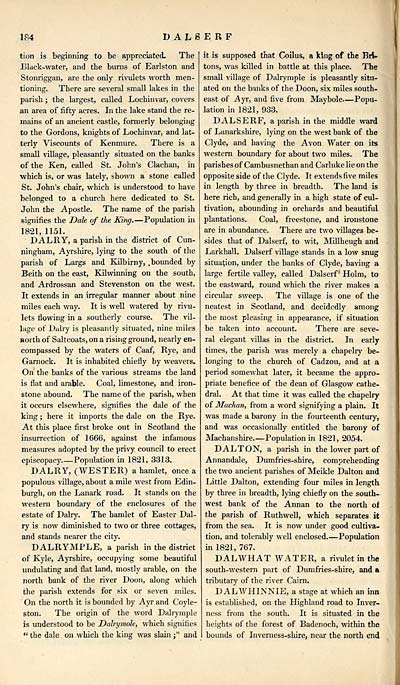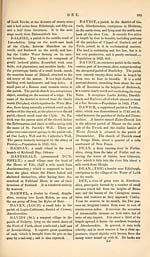Gazetteer of Scotland > Volume 1
(212) Page 184 - DAL
Download files
Complete book:
Individual page:
Thumbnail gallery: Grid view | List view

184
UALSERF
tion is beginning to be appreciated. The
Black-water, and the burns of Earlston and
Stonriggan, are the only rivulets worth men-
tioning. There are several small lakes in the
parish ; the largest, called Lochinvar, covers
an area of fifty acres. In the lake stand the re-
mains of an ancient castle, formerly belonging
to the Gordons, knights of Lochinvar, and lat-
terly Viscounts of Kenmure. There is a
small vUlage, pleasantly situated on the banks
of the Ken, called St. John's Clachan, in
which is, or was lately, shown a stone called
St. John's chair, which is understood to have
belonged to a church here dedicated to St.
John the Apostle. The name of the parish
signifies the Dale of the King. — Population in
1821, 1151.
DALRY, a parish in the district of Cun-
ningham, Ayrshire, lying to the south of the
parish of Largs and Kilbirny, .bounded by
Beith on the east, Kilwinning on the south,
and Ardrossan and Stevenston on the west.
It extends in an irregular manner about nine
miles each way. It is well watered by rivu-
lets flowing in a southerly course. The vil-
lage of Dairy is pleasantly situated, nine miles
north of Saltcoats, on a rising ground, nearly en-
compassed by the waters of Caaf, Rye, and
Garnock. It is inhabited chiefly by weavers.
On the banks of the various streams the land
is flat and arable. Coal, limestone, and iron-
stone abound. The name of the parish, when
it occurs elsewhere, signifies the dale of the
king ; here it imports the dale on the Rye.
At this place first broke out in Scotland the
insurrection of 1666, against the infamous
measures adopted by the privy council to erect
episcopacy Population in 1821, 3313.
DALRY, (WESTER) a hamlet, once a
populous village, about a mile west from Edin-
burgh, on the Lanark road. It stands on the
western boundary of the enclosures of the
estate of Dairy. The hamlet of Easter Dai-
ry is now diminished to two or three cottages,
and stands nearer the city.
DALRYMPLE, a parish in the district
of Kyle, Ayrshire, occupying some beautiful
undulating and flat land, mostly arable, on the
north bank of the river Doon, along which
the parish extends for six or seven miles.
On the north it is bounded by Ayr and Coyle-
ston. The origin of the word Dalrymple
is understood to be Dalrymole, which signifies
" the dale on which the king was slain ;" and
it is supposed that Coilus, a king of the Bri-
tons, was killed in battle at this place. The
small village of Dalrymple is pleasantly situ-
ated on the banks of the Doon, six miles south-
east of .Ayr, and five from Maybole — Popu-
lation in 1821, 933.
DALSERF, a parish in the middle ward
of Lanarkshire, lying on the west bank of the
Clyde, and having the Avon Water on its
western boundary for about two miles. The
parishes of Cambusnethan and Carluke lie on the
opposite side of the Clyde. It extends five miles
in length by three in breadth. The land is
here rich, and generally in a high state of cul-
tivation, abounding in orchards and beautiful
plantations. Coal, freestone, and ironstone
are in abundance. There are two villages be-
sides that of Dalserf, to wit, Millheugh and
Larkhall. Dalserf village stands in a low snug
situation, under the banks of Clyde, having a
large fertile valley, called Dalserf- Holm, to
the eastward, round which the river makes a
circular sweep. The village is one of the
neatest in Scotland, and decidedly among
the most pleasing in appearance, if situation
be taken into account. There are seve-
ral elegant villas in the district. In early
times, the parish was merely a chapelry be-
longing to the church of Cadzou, and at a
period somewhat later, it became the appro-
priate benefice of the dean of Glasgow cathe-
dral. At that time it was called the chapelry
of Machan, from a word signifying a plain. It
was made a barony in the fourteenth century,
and was occasionally entitled the barony of
Machanshire. — Population in 1821, 2054.
DAL TON, a parish in the lower part of
Annandale, Dumfries-shire, comprehending
the two ancient parishes of Meikle Dalton and
Little Dalton, extending four miles in length
by three in breadth, lying chiefly on the south-
west bank of the Annan to the north of
the parish of Ruthwell, which separates it
from the sea. It is now under good cultiva-
tion, and tolerably well enclosed. — Population
in 1821, 767.
DALWHAT WATER, a rivulet in the
south-western part of Dumfries-shire, and a
tributary of the river Cairn.
DALWHINNIE, a stage at which an inn
is established, on the Highland road to Inver-
ness from the south. It is situated in the
heights of the forest of Badenoch, within the
bounds of Inverness-shire, near the north end
UALSERF
tion is beginning to be appreciated. The
Black-water, and the burns of Earlston and
Stonriggan, are the only rivulets worth men-
tioning. There are several small lakes in the
parish ; the largest, called Lochinvar, covers
an area of fifty acres. In the lake stand the re-
mains of an ancient castle, formerly belonging
to the Gordons, knights of Lochinvar, and lat-
terly Viscounts of Kenmure. There is a
small vUlage, pleasantly situated on the banks
of the Ken, called St. John's Clachan, in
which is, or was lately, shown a stone called
St. John's chair, which is understood to have
belonged to a church here dedicated to St.
John the Apostle. The name of the parish
signifies the Dale of the King. — Population in
1821, 1151.
DALRY, a parish in the district of Cun-
ningham, Ayrshire, lying to the south of the
parish of Largs and Kilbirny, .bounded by
Beith on the east, Kilwinning on the south,
and Ardrossan and Stevenston on the west.
It extends in an irregular manner about nine
miles each way. It is well watered by rivu-
lets flowing in a southerly course. The vil-
lage of Dairy is pleasantly situated, nine miles
north of Saltcoats, on a rising ground, nearly en-
compassed by the waters of Caaf, Rye, and
Garnock. It is inhabited chiefly by weavers.
On the banks of the various streams the land
is flat and arable. Coal, limestone, and iron-
stone abound. The name of the parish, when
it occurs elsewhere, signifies the dale of the
king ; here it imports the dale on the Rye.
At this place first broke out in Scotland the
insurrection of 1666, against the infamous
measures adopted by the privy council to erect
episcopacy Population in 1821, 3313.
DALRY, (WESTER) a hamlet, once a
populous village, about a mile west from Edin-
burgh, on the Lanark road. It stands on the
western boundary of the enclosures of the
estate of Dairy. The hamlet of Easter Dai-
ry is now diminished to two or three cottages,
and stands nearer the city.
DALRYMPLE, a parish in the district
of Kyle, Ayrshire, occupying some beautiful
undulating and flat land, mostly arable, on the
north bank of the river Doon, along which
the parish extends for six or seven miles.
On the north it is bounded by Ayr and Coyle-
ston. The origin of the word Dalrymple
is understood to be Dalrymole, which signifies
" the dale on which the king was slain ;" and
it is supposed that Coilus, a king of the Bri-
tons, was killed in battle at this place. The
small village of Dalrymple is pleasantly situ-
ated on the banks of the Doon, six miles south-
east of .Ayr, and five from Maybole — Popu-
lation in 1821, 933.
DALSERF, a parish in the middle ward
of Lanarkshire, lying on the west bank of the
Clyde, and having the Avon Water on its
western boundary for about two miles. The
parishes of Cambusnethan and Carluke lie on the
opposite side of the Clyde. It extends five miles
in length by three in breadth. The land is
here rich, and generally in a high state of cul-
tivation, abounding in orchards and beautiful
plantations. Coal, freestone, and ironstone
are in abundance. There are two villages be-
sides that of Dalserf, to wit, Millheugh and
Larkhall. Dalserf village stands in a low snug
situation, under the banks of Clyde, having a
large fertile valley, called Dalserf- Holm, to
the eastward, round which the river makes a
circular sweep. The village is one of the
neatest in Scotland, and decidedly among
the most pleasing in appearance, if situation
be taken into account. There are seve-
ral elegant villas in the district. In early
times, the parish was merely a chapelry be-
longing to the church of Cadzou, and at a
period somewhat later, it became the appro-
priate benefice of the dean of Glasgow cathe-
dral. At that time it was called the chapelry
of Machan, from a word signifying a plain. It
was made a barony in the fourteenth century,
and was occasionally entitled the barony of
Machanshire. — Population in 1821, 2054.
DAL TON, a parish in the lower part of
Annandale, Dumfries-shire, comprehending
the two ancient parishes of Meikle Dalton and
Little Dalton, extending four miles in length
by three in breadth, lying chiefly on the south-
west bank of the Annan to the north of
the parish of Ruthwell, which separates it
from the sea. It is now under good cultiva-
tion, and tolerably well enclosed. — Population
in 1821, 767.
DALWHAT WATER, a rivulet in the
south-western part of Dumfries-shire, and a
tributary of the river Cairn.
DALWHINNIE, a stage at which an inn
is established, on the Highland road to Inver-
ness from the south. It is situated in the
heights of the forest of Badenoch, within the
bounds of Inverness-shire, near the north end
Set display mode to: Large image | Transcription
Images and transcriptions on this page, including medium image downloads, may be used under the Creative Commons Attribution 4.0 International Licence unless otherwise stated. ![]()
| Gazetteers of Scotland, 1803-1901 > Gazetteer of Scotland > Volume 1 > (212) Page 184 - DAL |
|---|
| Permanent URL | https://digital.nls.uk/97426906 |
|---|
| Description | Volume I: Abbey to Glenartney. |
|---|---|
| Attribution and copyright: |
|
| Description | By Robert Chambers and William Chambers. Glasgow: Blackie & Son, 1838. 2 volumes. |
|---|---|
| Shelfmark | NF.1461.g.7 |
| Additional NLS resources: | |

